Month: May 2013
New Firearms Retailer Provides an Indoor Shooting Range for an Area Long Neglected
Red Dot Firearms of Layton, Utah, joins the short list of gun ranges in Davis County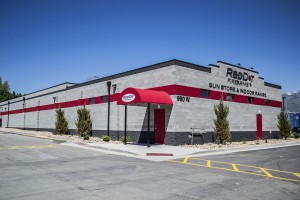
PROVO, Utah – May 22, 2013 – Davis County, Utah, recently welcomed a new kind of business to one of its largest shopping districts. Now you can get all of your grocery shopping done and hit the indoor shooting range all in the same place.
Red Dot Firearms, located just off I-15 exit 331 in Layton, recently opened its retail gun store and a 25 yard indoor shooting range capable of handling both handgun and rifle rounds including .5o BMG.
“We are the only retail firearms store in the area besides some of the big box stores, and we were the first place ever to apply for an indoor range license in the county,” owner Denny Wanlass said. “We felt like it was time people in the area had another option.”
According to Wanlass, many shooters in Utah have started moving their weekend shooting ventures away from public lands due to wildfires and other concerns, which means a higher demand for indoor ranges like Red Dot Firearms.
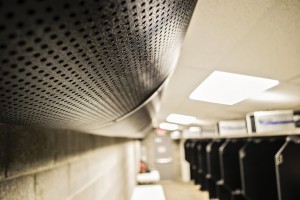
“A lot of people just drive out to the desert to shoot, but last summer, several wildfires were blamed on target shooting. Whether true or not, it’s still driving many shooters away from the wilderness areas and indoors,” Wanlass said. “That combined with the closures of public land and the increase in gas prices make our indoor range the perfect alternative.”
Shooters transitioning from the outdoors also get the added benefit of a climate controlled environment and a ventilation system installed by Carey’s Small Arms Range Systems that exceeds NIOSH, EPA and OSHA standards.
“We wanted a good ventilation system because we take our customers’ health very seriously,” Wanlass said. “Just about every person who has come out of there has said, ‘I love being in a range where I can breathe!’”
Fellow Utah business Action Target was contracted to install the range equipment at Red Dot Firearms including a 48-foot wide steel funnel bullet trap, armor steel ceiling and wall baffles to prevent rounds from escaping, and shooting stalls capable of stopping rifle rounds from point blank range.
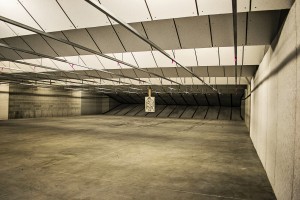
“Throughout the course of our research, it was clear that there really isn’t anyone else besides Action Target that is worth using,” Wanlass said. “The equipment on our range is second to none, and that means our customers can shoot with complete confidence that their safety is never going to be jeopardized.”
Red Dot Firearms is now open Monday through Friday from 10 a.m. to 8 p.m. and Saturday from 10 a.m. to 6 p.m. Classes in concealed carry, personal defense, hunter’s safety and more will be held regularly.
The Truth About Steel and Steel Targets, Pt. 2
When it comes to steel targets, it is important to understand there are crucial differences in the quality of the steel used to make the targets and the design of the targets themselves. In an age where it seems everyone “knows a guy” who can make steel targets for them out of a welding shop, understanding the facts about steel is even more important. Steel targets can be perfectly safe and a fantastic training tool if done right, but they can also be extremely dangerous if done wrong. Here at Action Target, we have been designing and manufacturing steel targets![]() and tactical training systems for nearly 30 years. Here are some of the things we’ve learned along the way.
and tactical training systems for nearly 30 years. Here are some of the things we’ve learned along the way.
TRUTH – THERE IS A SIGNIFICANT DIFFERENCE IN THE QUALITY OF STEEL BEING USED
Unfortunately, there are steel targets out there that are poorly designed and are made of inferior steel. Homemade targets from local welding shops are usually the culprits, but some commercial target manufacturers use inferior steel as well. Because these targets are vulnerable to cratering, pocking, and general deformation, they are very dangerous and should be avoided. Any steel with a Brinell hardness rating under 400 falls into this category, including standard “T-1” steel with a hardness rating in the 300 range.
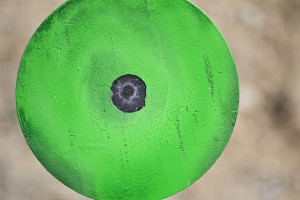
After many years of experimenting to find the best solution, most major manufacturers of dependable, high quality steel targets now use steel with a Brinell hardness rating of at least 400. A few premium quality manufacturers use steel with a higher Brinell hardness rating of 500 or even 550. Fewer than 10 steel mills in the world can provide quality AR500/550 steel. Action Target has direct relationships with many of these suppliers which allows us to purchase steel mill direct. Steel of this quality is always certified by the plant that created it, however, at Action Target we conduct independent hardness testing on every shipment we receive. If the steel does not meet our ballistic standards, we reject the entire order and send it back.
Other steel certifications like “Magnum Steel” or “Extreme Steel” are merely marketing terms added by the manufacturer. When all the rhetoric is boiled away, there are manufacturers who use steel that is not appropriate for targets, and there are those who use steel that is. Make sure you know the difference.
PROPER DESIGN IS CRITICAL
Even the best steel can’t compensate for poorly designed targets. There are several unavoidable principles that must be followed to create targets that are as safe and durable as possible.
![PT Torso (all sides) [web]](https://www.actiontarget.com/wp-content/uploads/2013/05/PT-Torso-all-sides-web-300x300.jpg)
TRUTH – SMOOTH AND TOTALLY FLAT SHOOTING SURFACES ARE ESSENTIAL FOR CONSISTENT SPLATTER PATTERNS
There are two things manufacturers can do to ruin the smoothness and flatness of a steel target. First, they can use inferior steel that will crater, pock, and deform. Second, they can put brackets, clamps, or bolts in the way of the shooting surfaces. Remember, anything that can be shot will be shot. Why is this an issue? Because you can do a reasonable job of predicting and protecting against a bullet’s splatter pattern when it hits a flat, uniform surface. If the steel is damaged or if anything else is in the way, all bets are off. Bullet fragmentation and ricochet are inherent and acknowledged issues when shooting on steel targets. Proper target design helps you address those issues with the highest degree of safety possible.
TRUTH – DISSIPATING A BULLET’S ENERGY IS SAFER AND HELPS YOUR TARGETS LAST LONGER
When a bullet strikes a steel target that is completely stationary at a 90-degree angle, all the bullet’s energy goes directly to weakening that point on the steel. If the target is completely stationary but is positioned at less than a 90-degree angle, a portion of the bullet’s energy at impact is deflected rather than absorbed. If the target is positioned at slightly less than a 90-degree angle AND the target is able to move on impact, a much larger portion of the bullet’s energy is deflected rather than absorbed.
NO STEEL TARGET IS INDESTRUCTIBLE
Without exception, every steel target out there today can be damaged. Steel hardness and proper design can both be defeated by misuse and/or abuse of the target.
TRUTH – THE BASIC DESTRUCTIVE FORCE GENERATED BY BULLETS STRIKING STEEL TARGETS IS HEAT
Excessive concentrated heat alters the steel’s hardness properties and results in damage to the target’s face. The amount of heat generated is proportional to the speed of the bullet, which is why rifles cause more damage to steel targets than handguns.
TRUTH – RIFLE DISTANCE ON STEEL TARGETS IS NOT AN EXACT SCIENCE
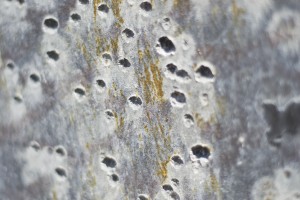
No matter what anyone tells you, shooting a steel target with a rifle – even at 100 yards – can damage your target, even if it has a Brinell hardness rating of 550. You must be very careful about your choice of steel and ammunition! Even with 550 Brinell steel and the target mounted at a significant angle, some damage is still possible, even at 100 yards. For best results, use only steel targets![]() that are specifically designed for use with rifles.
that are specifically designed for use with rifles.
With so many complex variables like ammunition type, rifle manufacturer, barrel length, bullet velocity and so on, it is virtually impossible to establish a set distance for shooting rifles on steel targets. To determine what works best with your specific equipment, we suggest the following: Fire a test shot from 100 yards and then examine the target. If there is no damage, move in a few yards and fire another test shot. Repeat the process until you find the optimal distance for your combination of rifle and ammunition. Some people may be comfortable with a certain amount of dimpling on the steel. Minor damage to the shooting surface will not create a shooting hazard if you are shooting at 100 yards, but if can be very dangerous if you choose to shoot at close range with a handgun on the same target. Even if your steel targets have only minimal rifle damage, they should never be used for closer distance handgun training.
TRUTH – SHOTGUN SLUG DISTANCE ON STEEL TARGETS MEANS 100 YARDS MINIMUM
Shotgun slugs have the greatest potential for bodily harm to the shooter due to the sheer volume of lead that can be returned from damaged or poorly designed steel targets. Stay back!
TRUTH – FRANGIBLE AMMUNITION REQUIRES THE SAME QUALITY STEEL AS REGULAR AMMUNITION
Many types of frangible ammunition, particularly for rifles, are lighter than regular lead ammunition. Remember that lighter bullets can mean greater speed, which means more heat, which can mean damage to your steel target. Just because frangible ammunition is designed to break up on impact doesn’t mean the distance requirements do not apply. You should follow the exact same rules with frangible ammunition as you do with any other.
TRUST THE EXPERTS
When it comes to your safety, don’t settle for the advice of your local welder. Steel targets can be fun and safe as long as they are made of quality steel and designed to produce predictable splatter. In fact, steel targets can be one of the greatest tools for firearms training, but they have to be manufactured correctly. Shooting on poorly designed targets made of inferior steel can result in severe bodily harm. Here at Action Target, your safety is our biggest concern. We have decades of experience manufacturing steel targets, and we constantly conduct ballistic research to make sure the steel we use meets our standards and your expectations. If you are looking for a steel target, trust us to point you in the right direction.
Bullet Trap Comparisons, Pt. 2
Building a shooting range can be a daunting task. There are so many different things to consider and decisions to make that it can become a little overwhelming. One issue that seems to confuse potential range owners the most is bullet containment. Without a doubt, bullet containment is the most important aspect of every indoor and outdoor range. Proper containment of fired rounds means safety for your employees and customers, but with so many different types of bullet traps available on the market that promise to do this or that, choosing the right system can be hard. The purpose of this article is to provide accurate information and valuable education by examining various bullet trap theories, technologies, and applications in an objective manner.
The following information represents the views and opinions of Action Target based on our experience and observations. You are encouraged to conduct your own research and speak with other users about their experiences with the various bullet trap technologies presented.
Rubber Lamella Trap
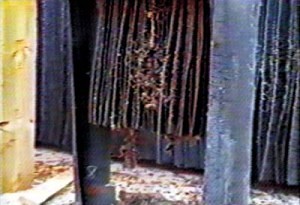 With this trap, tightly grouped rubber curtains or lamellas are hung from a support structure to create a bullet stopping barrier. As bullets pass through the layers of rubber strips, their energy is dissipated until they come to a stop. A steel plate is mounted at the back of the trap to block rounds that make it through the lamellas.
With this trap, tightly grouped rubber curtains or lamellas are hung from a support structure to create a bullet stopping barrier. As bullets pass through the layers of rubber strips, their energy is dissipated until they come to a stop. A steel plate is mounted at the back of the trap to block rounds that make it through the lamellas.
Because rubber is destroyed every time you shoot into it, the rubber strips are quickly shredded under any kind of moderate to heavy use. One of the most quoted features of rubber traps is that bullets don’t fragment on impact like they do on steel. This is true until bullets start impacting other bullets already embedded in the rubber.
Regardless of the application, the use of a rubber bullet trap introduces a very real fire hazard that must be considered and dealt with appropriately
The benefits of a lamella trap include its small floor space requirement, and the ability to capture some bullets whole.
Weaknesses include high maintenance costs, fire hazard, messy appearance, and the restriction of low volume shooting only.
Vertical Rubber Granule Trap
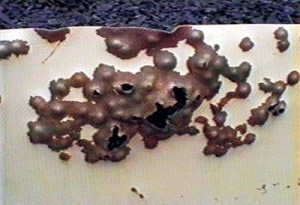 Another European design uses a large steel chamber filled with chopped rubber and a penetrable rubber sheet across the front the keep the rubber granules in place.
Another European design uses a large steel chamber filled with chopped rubber and a penetrable rubber sheet across the front the keep the rubber granules in place.
The trap works the same way a sand berm works, except the sand is replaced by granules of chopped rubber and the face of the trap is vertical. Like the rubber lamella trap, the front skin of the rubber granule trap is permanently damaged each time a bullet is fired into it.
As larger and larger holes are created in the front skin, rubber granules can spill out and large bulges can develop as the structural integrity of the trap is compromised. Regular patching and repair is often required to keep the granules in the chamber.
As the granules settle, areas of dangerously low density can form at the top of the trap causing rounds to pass through the rubber and escape out the back. To clean the trap, bullets must be mined and separated from the rubber then disposed of properly.
The benefits of a vertical rubber granule trap include its small floor space requirement, the ability to capture some bullets whole, and reduced lead dust levels.
Weaknesses include massive ongoing maintenance, service costs, fire hazard, and the restriction of low volume shooting only.
Rubber Block Trap
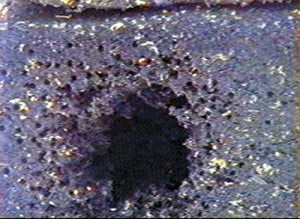 The rubber block trap is similar in concept to the rubber granule trap, except the rubber granules are molded together to form a solid object. The rubber blocks are stacked on top of each other to create a wall that serves as the bullet trap. When a bullet is fired into the blocks, it is stopped and stored within the block itself. Like all rubber traps, the blocks are damaged with every shot and large holes can quickly develop, severely limiting the trap’s ability to stop bullets. As the holes get larger, the blocks get weaker and the whole wall tends to collapse under its own weight.
The rubber block trap is similar in concept to the rubber granule trap, except the rubber granules are molded together to form a solid object. The rubber blocks are stacked on top of each other to create a wall that serves as the bullet trap. When a bullet is fired into the blocks, it is stopped and stored within the block itself. Like all rubber traps, the blocks are damaged with every shot and large holes can quickly develop, severely limiting the trap’s ability to stop bullets. As the holes get larger, the blocks get weaker and the whole wall tends to collapse under its own weight.
The benefits of a rubber block trap include its small floor space requirement and the ability to capture some bullets whole.
Weaknesses include UV breakdown, significant ongoing maintenance, fire hazard, and structural collapse.
Wet Funnel Trap
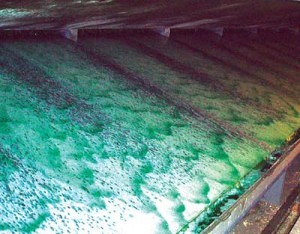 The wet funnel trap incorporates gently sloping steel plates that reduce bullet fragmentation on impact. As bullets hit the plates, they are directed to the narrow end of the funnel and enter a deceleration chamber where their energy is dissipated.
The wet funnel trap incorporates gently sloping steel plates that reduce bullet fragmentation on impact. As bullets hit the plates, they are directed to the narrow end of the funnel and enter a deceleration chamber where their energy is dissipated.
While the upper impact plates remain dry, the lower plates are constantly flooded with a water and oil mixture that is intended to lubricate the steel. The water is continually recycled as it flows down the plates and into a holding tank where it is electrically pumped out and again sprayed on to the plates.
On indoor ranges, some wet trap owners report that the increased humidity can leave an oily film on the rest of the range and may cause HEPA filters in the ventilation system to clog. They have also discovered that frangible ammunition can cause problems because the powder created by disintegrating bullets mixes with the water and hardens into a cement-like substance that requires an extremely difficult cleaning process.
It has been recommended to treat the water with chlorine to prevent algae in warm climates, and antifreeze to prevent freezing in colder climates. These substances combine with the water, oil, and lead, and can create a significant hazardous waste problem.
The benefits of a wet funnel trap include the durability of steel, reduced bullet fragmentation, reduced lead dust levels, and the ability to handle larger calibers.
Weaknesses include its higher cost, large floor space requirement, water treatment chemicals, increased humidity, problems with frangible ammunition, maintenance of the electric pumps and filters, and its nonmodular construction.
Vertical Funnel Trap
 Instead of a continuous horizontal funnel, this trap uses a series vertically oriented funnel boxes to gather the bullets. As with a horizontal funnel, bullets are deflected by the impact plates into a deceleration chamber at the back of the trap where they are collected and stored.
Instead of a continuous horizontal funnel, this trap uses a series vertically oriented funnel boxes to gather the bullets. As with a horizontal funnel, bullets are deflected by the impact plates into a deceleration chamber at the back of the trap where they are collected and stored.
The angles of the impact plates are not as severe as a venetian blind or escalator type trap, but they are more severe than other modern steel traps so bullet fragmentation on impact can still be an issue.
As individual chambers are mounted next to each other, vertical edges that run from the top to the bottom of the trap are created. These edges can pose a significant ricochet hazard. Additionally, the individual chamber design prohibits any cross-lane shooting and greatly limits the flexibility and functionality of the trap as a whole.
The benefits of a vertical funnel trap include the durability of steel, easier lead collection, and a smaller floor space requirement.
Weaknesses include bullet fragmentation, no close-range shooting, and no cross-lane shooting.
Rely on the Experts for Help
There are hundreds of things to take into consideration when building a shooting range, but your top priority should always be safety. Before anything else, make sure your range is going to be safe for your customers, your employees, and the environment. If you are considering building a range, talk to the Action Target representative in your region and he will be happy to help you find the right equipment to fit your needs and budget.
VIDEOS: The Biggest Bullet Trap in the World / Michael Bane Endorses Action Target’s Rimfire Steel
Industry film company Panteao Productions recently stopped by Lotus Gunworks in Jensen Beach, Florida, to film in the first indoor double-decker shooting range Action Target has ever built. Take a tour of one of the most extensive firearms selections in South Florida and the only indoor range to feature a two-story steel funnel bullet trap. Watch it here:
Panteao Productions, known for its in-depth firearms training videos, will be coming out with a new Make Ready DVD in the near future on .22 rimfire training featuring the expertise of TV host Michael Bane and 30-year IDPA and USPSA veteran competitor Tom Yost. To film the training video, Panteao Productions exclusively used Action Target’s new Rimfire Steel![]() target line and even filmed a brief endorsement from Michael Bane. Watch it here:
target line and even filmed a brief endorsement from Michael Bane. Watch it here:






